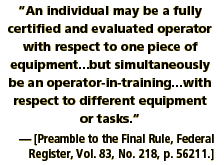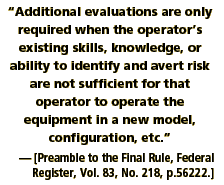March 2019—You’ve read the Final Rule, OSHA’s FAQs, and the NCCCO Employers Guides*. You’ve watched the SC&RA webinar and reviewed the Employer Evaluation Forms**. You’ve even taken a stab at scanning the Preamble*. But you still have questions.
Following are eight questions you might have asked yourself, along with some answers that may help you navigate around OSHA’s new rules for crane operator qualifications.
I HEARD OSHA HAS POSTPONED SOME PART OF THIS RULE?
That’s correct. According to an announcement by OSHA last month, you must still conduct evaluations of trained and certified operators now, but documentation of those evaluations can wait until April 15.
CAN A TRAINED AND CERTIFIED OPERATOR STILL BE CATEGORIZED AS AN OPERATOR-IN-TRAINING?
 Yes. Although it sounds odd, until certified operators are also evaluated for the specific configuration of crane and the type of work they are about to do, they are still considered by OSHA to be “operators-in-training” and subject to the restrictions that govern them.
Yes. Although it sounds odd, until certified operators are also evaluated for the specific configuration of crane and the type of work they are about to do, they are still considered by OSHA to be “operators-in-training” and subject to the restrictions that govern them.
ONCE AN OPERATOR IS EVALUATED FOR THE CONFIGURATION OF CRANE AND TYPE OF WORK THEY WILL DO, CAN THEY STILL BE OPERATORS-IN-TRAINING?
Yes. OSHA said in the Preamble to the Final Rule that an individual may be a fully certified and evaluated operator with respect to one piece of equipment, but simultaneously be an operator-in-training with respect to different equipment or tasks that require significantly different skills or knowledge.
 HOW DO I KNOW WHEN I HAVE TO EVALUATE AN OPERATOR AGAIN?
HOW DO I KNOW WHEN I HAVE TO EVALUATE AN OPERATOR AGAIN?
When the skills, knowledge, or ability of the operator are not sufficient for him or her to operate that crane in a given configuration or situation. The employer (or an agent of the employer) has to make that determination. But note that OSHA also said (again in the Preamble) that employers are not required to evaluate their operators in every possible configuration of equipment or combination of configuration and boom length.
WHAT ELSE CAN TRIGGER EVALUATIONS?
When there is evidence from an operator’s knowledge or performance that retraining is necessary. And retraining must always be followed up with re-evaluation. Examples of such evidence might be incidents, near-misses, or misinterpreting load charts or hand signals.
HOW DO I DETERMINE WHO IS QUALIFIED TO CONDUCT THE EVALUATIONS?
OSHA said the evaluator must be someone with the knowledge, training, and experience necessary to assess equipment operators. While a current or former crane operator might also be an evaluator, the knowledge, training, and experience needed to operate a crane may not be sufficient. Note that you cannot rely on OSHA’s standard definition of a “qualified person” here.
IF I HIRE AN OPERATOR AND HE BRINGS HIS CERTIFICATION CARD AND HIS EVALUATIONS BY A PREVIOUS EMPLOYER DO I NEED TO EVALUATE HIM AGAIN?
Yes. OSHA does not allow you to rely on evaluations conducted by a previous employer.
IF I WORK IN A STATE OR CITY THAT REQUIRES LICENSING, DO I ALSO HAVE TO BE CERTIFIED?
Only if the license meets OSHA’s requirements for written and practical exams. If it does not, your operators must then also be certified as well as licensed.
*These can all be downloaded from NCCCO’s OSHA Crane Rule Resource Center at nccco.org/oshas-crane-rule.
** Go to scranet.org for further information.